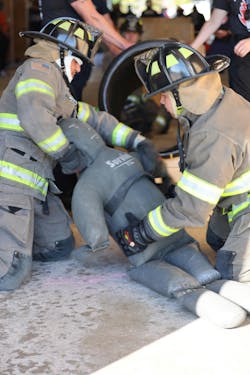Don’t Blame the Lettuce! Developing the Next Generation of First Responders
Whether you are a fire instructor who works with students or an officer who works with a new recruit or is leading a high school cadet program, a common struggle often is relating to and understanding the next generation of first responders. Common complaints include:
- They’re on their phone all of the time.
- They don’t know how to communicate.
- They don’t want to do a job where they must work hard.
- They lack the basic skills that recruits used to have.
- They job-hop too much.
- They don’t take initiative.
- They’re offended too easily.
Placing blame on young people or simply expecting them to be where you want them to be is like hitting the “easy button.” Instructors, officers and experienced members of departments have a duty and honor to shape the future of young firefighters. The answer to the struggle of relating to the next generation lies within. However, it requires courage to see a perspective through a different lens and vulnerability to try things that are outside of your comfort zone. It doesn’t matter how things were when you came on the job. It only matters how things are now.
Don’t blame the lettuce!
A quote that has become a great reminder in fire/EMS training classrooms of Waukesha County Technical College (WCTC) is from Thich Nhat Hanh: “When you plant lettuce, if it does not grow well, you don’t blame the lettuce. You look for reasons it is not doing well. It may need fertilizer, or more water, or less sun. You never blame the lettuce.” Shifting from blaming incoming recruits to taking ownership to produce change as instructors and senior members is what ultimately sets apart departments and training programs as the employers and training centers of choice.
Adolescent brain power
Risky, emotional, rebellious, restless, impulsive and lacking basic skills are words and phrases that some might use when they think of teenagers. At times, behaviors of teenagers and young adults can boggle the mind. Some older people often might shake their head and just think, “Why?” Understanding the development of the adolescent brain can help you to better understand their predisposition and why they present with certain behaviors.
Anatomy teaches us that the brain develops from the back to the front. The prefrontal cortex of the frontal lobe, which is responsible for planning, problem-solving, emotional regulation and concentration, isn’t developed fully until a person reaches about the age of 25.
In the past, researchers saw the adolescent brain as a liability and something that needed to be controlled. More current research focuses on the fact that neural pathways still are developing at an astonishing rate in the teenage years and early 20s. This allows for the deduction that the adolescent brain is curious, energetic, expressive, adventurous, creative, flexible and moldable and is primed for new information. It’s all in how you harness the opportunity. Change your perspective, and you can see opportunity, where before you only saw challenges.
Meet them where they are
One of the most important skills that you can learn in life is to focus on what’s within your circle of control. Placing blame on the next generation for not being motivated enough, not having the basic skills that you hope that they would have and/or not communicating in the manner that you prefer them to communicate only leads to additional frustrations.
Another statement that’s become a slogan in WCTC classrooms is to “meet them where they are at” and then guide them into developing what we need them to be. That said, you absolutely can’t lower your expectations. In fact, you might have to work a little harder to help the student meet them.
Many seasoned firefighters and instructors are concerned about the lack of basic skills that students and new recruits possess. Much of this could be attributed to what Jonathan Haidt, who is the author of “The Anxious Generation,” attributes to over-parenting in the real world and under-parenting in the technical world. Parents of Generation Z didn’t spend time to teach their children how to cook, do laundry, fix the lawnmower, use tools or manage their own conflict. Rather than spending time wishing that students and recruits have those basic skills, you should seize on the opportunity to teach them. When instructors take the time to show a student or new recruit how to do something and then provide frequent and meaningful feedback, many students gain confidence and feel valued as a team member.
Strategies to engage
A mnemonic that was developed by the WCTC fire/EMS academy’s lead instructor helps seasoned members and instructors to learn to better engage the younger generation. These LMNOP strategies help to tackle many of the common complaints that are listed above.
Listen to them. When it feels as though a student or recruit lacks initiative or motivation, it’s time to start asking targeted questions. If you create an environment in which they feel comfortable to share, you often learn that their hesitancy to jump in has nothing to do with the assumptions that you might have made. This gives you a window into their thoughts and helps you to develop a plan to meet them where they are at and to get them to where you need them to be.
Mentor them. Students and recruits who lack basic skills present an opportunity to teach them. It isn’t enough to ask them whether they know how to do something, let alone assume that they already know. Ask students and recruits to show you and then provide feedback on what they did well and, more importantly, how they can do it better.
Nonjudgmental. We often hear that students and recruits are too sensitive or are offended too easily. As the most diverse generation, members of Generation Z, in general, are simply less tolerant of social injustice, hazing, harassment and lack of respect. They know their place but want to feel valued as a team member.
Open-minded. Recognize that the perception of failure to communicate might be more related to the communication not being in a student’s or recruit’s preferred method. Typically, they prefer text, social media, instant messaging or even face to face, depending on the circumstance. WCTC’s fire/EMS program uses the GroupMe app as a way for quick reminders or communications.
Practice patience. When it seems as though students or recruits give up too easily, you must remember what it was like when you entered the fire service and didn’t have all of the knowledge and experience that you have currently. In a world in which overstimulation is the norm, it’s important to filter out the noise and break down larger tasks and goals into bite-size chunks. Make learning fun, keep it active, and create competition to keep it engaging.
The magic bullet
For those who have been looking for it, there is no magic bullet that’s going to “fix” the next generation. Nothing will make people be where you want them to be. The good news is that you have full control. You are the difference between dealing with a “problem” or taking on an opportunity. You have the power to shape the future of the fire service, and what an honor that is.
Know Your Audience
The best instructors perform an audience analysis to create the best and most effective learning environment for their students.
To better understand younger people, it’s helpful to have a basic understanding about
the different generations.
GENERATION Z (1997–2012) is the generation that currently is entering the workforce. Most of Generation Z was at a very developmental time during the COVID pandemic, and they grew up in an environment that focused on flexibility. They experienced the great recession, which means that they’re concerned with ensuring financial stability. They also are the most diverse generation and the first generation to be true digital natives. They don’t tolerate social injustice, and they expect that employers will use modern technology. It isn’t unusual for them to use multiple screens at once, and they have become known as great multitaskers. This generation values opportunities for growth and development and isn’t afraid to seek new opportunities when employers don’t meet their expectations. They value clear communication, transparency and frequent feedback.
GENERATION Y (1981–1996), or MILLENNIALS, grew up in an age of school shootings, the 9/11 attacks and the emergence of the internet. This group prefers to work independently and values time off and work/life balance. They also look for opportunities to lead.
GENERATION X (1965–1980) grew up pre-internet and learned to use technology in early adulthood. They also are referred to as the latchkey generation and had to learn many life skills at an early age. They are used to working hard and in teams and often are results/profit-driven.
BABY BOOMERS (1946–1964) struggle the most with technology but also typically are the hardest working individuals and extremely loyal to their employer.
Researching the differences among generations can help to understand how to relate to others; however, there are commonalities that can be discovered. Finding meaning in your work, having a sense of belonging, feeling valued and respected, and having opportunities for growth are similarities across all generations.

Courtney Hull
Courtney Hull serves as the associate dean of fire/EMS training at Waukesha County Technical College. She served in the field as a career firefighter/AEMT with the Menomonee Falls, WI, Fire Department prior to transitioning to a full-time role in fire and EMS education in 2010. Hull has a master’s degree in training and development.







